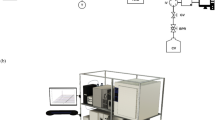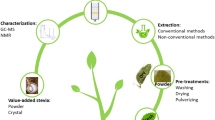Abstract
In order to separate epigallocatechin-3-gallate (EGCG) from tea polyphenols, the adsorption ability of resins chosen toward catechins was investigated. According to static adsorption results of resins selected, polyamide displayed better selective adsorption ability between esterified and non-esterified catechins, and LSA-10 distinguished EGCG from ECG very well among esterified catechins. Therefore, columns packed with polyamide and resin LSA-10 were adopted in the first and second purification of EGCG, respectively. After the first-run purification, the product can be obtained with a 70.27 % EGCG purity and 80.21 % recovery. After the second-run separation, product contained an EGCG purity of 95.14 % and a total recovery of 76.78 % can be achieved. Moreover, a higher per volume adsorption material load amount 51.02 mg mL−1 tea polyphenols and yield 24.11 mg mL−1 EGCG were obtained in the study. Furthermore, only ethanol solution was used as elution reagent in the process. In the study, a method that is environmentally friendly, with lower cost and better repeatability has been developed. This result will be of help in development of tea resources and applications on a large scale.






Similar content being viewed by others
References
Vuong QV, Golding JB, Nguyen M, Roach PD (2010) Extraction and isolation of catechins from tea. J Sep Sci 33:3415–3428
Chen C, Qiu H, Gong J, Liu Q, Xiao H, Chen XW, Sun BL, Yang RG (2012) (-)-Epigallocatechin-3-gallate inhibits the replication cycle of hepatitis C virus. Arch Virol 157:1301–1312
Lin SM, Wang SW, Ho SC, Tang YL (2010) Protective effect of green tea (-)-epigallocatechin-3-gallate against the monoamine oxidase B enzyme activity increase in adult rat brains. Nutrition 26:1195–1200
Du X, Huang X, Huang C, Wang Y, Zhang Y (2012) Epigallocatechin-3-gallate (EGCG) enhances the therapeutic activity of a dental adhesive. J Dent 40:485–492
Engel MFM, vandenAkker CC, Schleeger M, Velikov KP, Koenderink GH, Bonn M (2012) The polyphenol EGCG inhibits amyloid formation less efficiently at phospholipid interfaces than in bulk solution. J Am Chem Soc 134:14781–14788
Hossain MM, Banik NL, Ray SK (2012) Survivin knockdown increased anti-cancer effects of (-)-epigallocatechin-3-gallate in human malignant neuroblastoma SK-N-BE2 and SH-SY5Y cells. Exp Cell Res 318:1597–1610
Baluchnejadmojarad T, Roghani M (2011) Chronic epigallocatechin-3-gallate ameliorates learning and memory deficits in diabetic rats via modulation of nitric oxide and oxidative stress. Behav Brain Res 224:305–310
Narotzki B, Reznick AZ, Aizenbud D, Levy Y (2012) Green tea: a promising natural product in oral health. Arch Oral Biol 57:429–435
Xu Y, Zhu J, Zhou B, Luo D (2012) Epigallocatechin-3-gallate decreases UVA-induced HPRT mutations in human skin fibroblasts accompanied by increased rates of senescence and apoptosis. Exp Ther Med 3:625–630
Pae M, Ren Z, Meydani M, Shang F, Smith D, Meydani SN, Wu D (2012) Dietary supplementation with high dose of epigallocatechin-3-gallate promotes inflammatory response in mice. J Nutr Biochem 23:526–531
Kumar N, Savitri RM (2005) Separation of catechin constituents from five tea cultivars using high-speed counter-current chromatography. J Chromatogr A 1083:223–228
Ryszard AFS, Wieslaw W (2003) Separation of individual catechins from green tea using silica gel column chromatography and HPLC. J Food Lipids 10:165–177
Lai SM, Gu JY, Huang BH, Chang CM, Lee WL (2012) Preparative separation and purification of epigallocatechin gallate from green tea extracts using a silica adsorbent containing beta-cyclodextrin. J Chromatogr B Analyt Technol Biomed Life Sci 887–888:112–121
Xu J, Tan T, Janson JC (2007) One-step purification of epigallocatechin gallate from crude green tea extracts by mixed-mode adsorption chromatography on highly cross-linked agarose media. J Chromatogr A 1169:235–238
Zhu H, Qin P (2011) Separation of epigallocatechin-3-gallate from crude tea polyphenols by using Cellulose diacetate graft β-cyclodextrin copolymer asymmetric membrane. Front Chem Sci Eng 5:330–338
Ye JH, Wang LX, Chen H, Dong JJ, Lu JL, Zheng XQ, Wu MY, Liang YR (2011) Preparation of tea catechins using polyamide. J Biosci Bioeng 111:232–236
Gao M, Wang X, Gu M, Su Z, Wang Y, Janson JC (2011) Separation of polyphenols using porous polyamide resin and assessment of mechanism of retention. J Sep Sci 34:1853–1858
Wang S, Liang Y, Zheng S (2012) Separation of epigallocatechin gallate from tea polyphenol by simulated moving bed chromatography. J Chromatogr A 1265:46–51
Gao R, Liu H, Peng Z, Wu Z, Wang Y, Zhao G (2012) Adsorption of (-)-epigallocatechin-3-gallate (EGCG) onto oat β-glucan. Food Chem 132:1936–1943
Ye JH, Jin J, Liang HL, Lu JL, Du YY, Zheng XQ, Liang YR (2009) Using tea stalk lignocellulose as an adsorbent for separating decaffeinated tea catechins. Bioresour Technol 100:622–628
Li J, Chen Z, Di D (2012) Preparative separation and purification of Rebaudioside A from Stevia rebaudiana Bertoni crude extracts by mixed bed of macroporous adsorption resins. Food Chem 132:268–276
Dong ZB, Liang YR, Fan FY, Ye JH, Zheng XQ, Lu JL (2011) Adsorption behavior of the catechins and caffeine onto polyvinylpolypyrrolidone. J Agric Food Chem 59:4238–4247
Liu Y, Bai Q, Lou S, Di D, Li J, Guo M (2012) Adsorption characteristics of (-)-epigallocatechin gallate and caffeine in the extract of waste tea on macroporous adsorption resins functionalized with chloromethyl, amino, and phenylamino groups. J Agric Food Chem 60:1555–1566
Gogoi P, Dutta NN, Rao PG (2010) Adsorption of catechin from aqueous solutions on polymeric resins and activated carbon. Indian J Chem Tech 17:337–345
Wang Y, Li Q, Wang Q, Li Y, Ling J, Liu L, Chen X, Bi K (2012) Simultaneous determination of seven bioactive components in oolong tea Camellia sinensis: quality control by chemical composition and HPLC fingerprints. J Agric Food Chem 60:256–260
Xu J, Zhang G, Tan T, Janson JC (2005) One-step purification of epigallocatechin gallate from crude green tea extracts by isocratic hydrogen bond adsorption chromatography on beta-cyclodextrin substituted agarose gel media. J Chromatogr B Analyt Technol Biomed Life Sci 824:323–326
Acknowledgments
This study was supported by the 12th Five-Year Plan for Science and Technology Development of China [related with the metabolic syndrome (diabetes, high-fat model. et al)] (No. 2012BAD33B05).
Conflict of interest
The authors declare that they have no conflict of interest.
Author information
Authors and Affiliations
Corresponding author
About this article
Cite this article
Wang, W., Ma, C., Chen, S. et al. Preparative Purification of Epigallocatechin-3-gallate (EGCG) from Tea Polyphenols by Adsorption Column Chromatography. Chromatographia 77, 1643–1652 (2014). https://doi.org/10.1007/s10337-014-2764-z
Received:
Revised:
Accepted:
Published:
Issue Date:
DOI: https://doi.org/10.1007/s10337-014-2764-z




